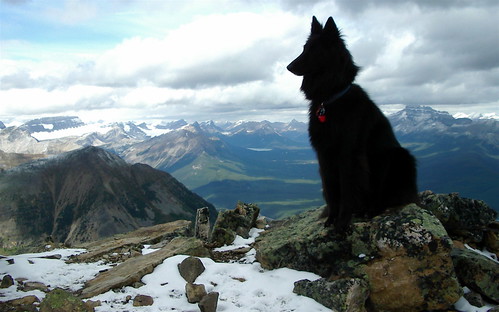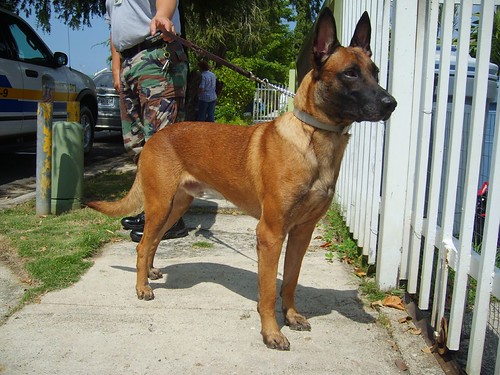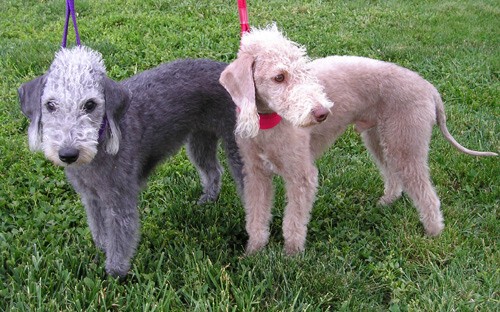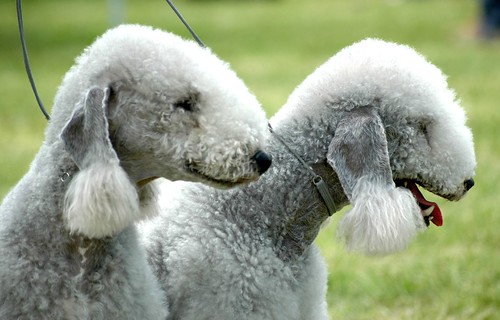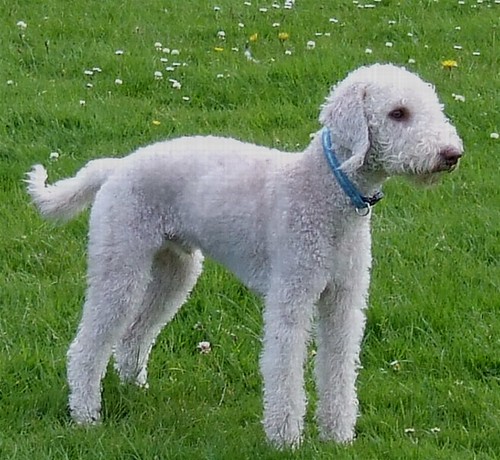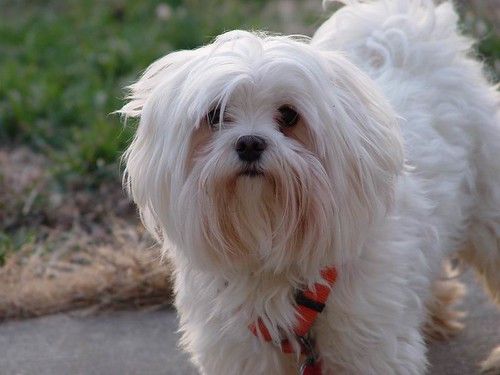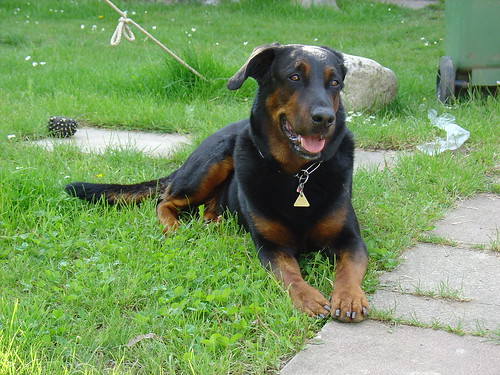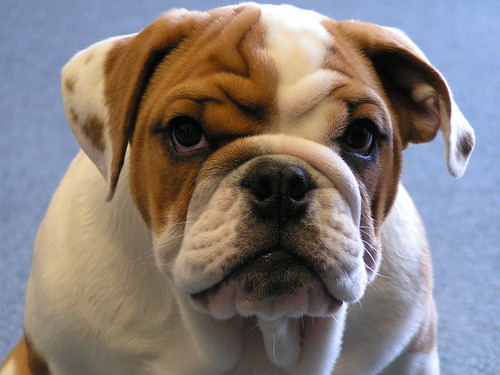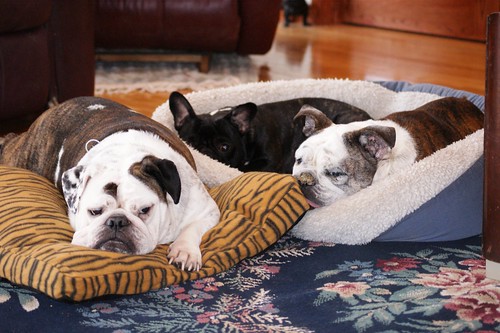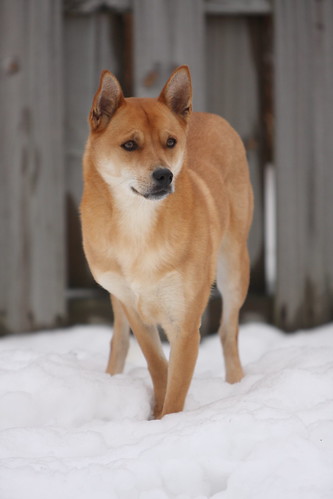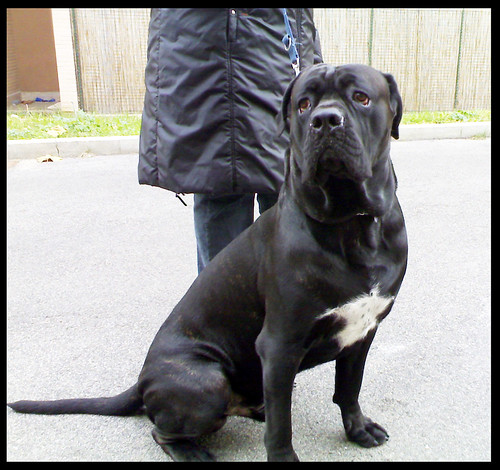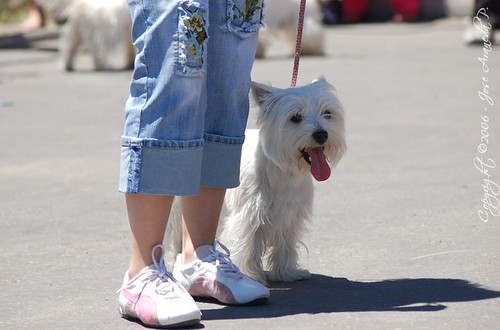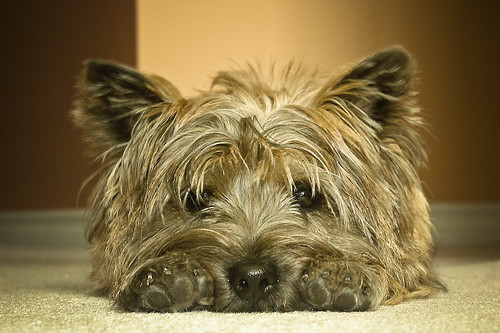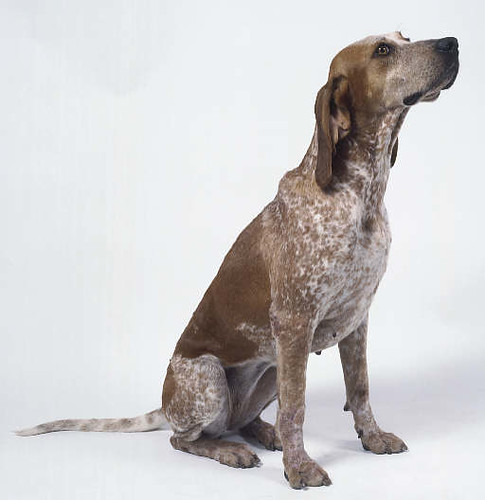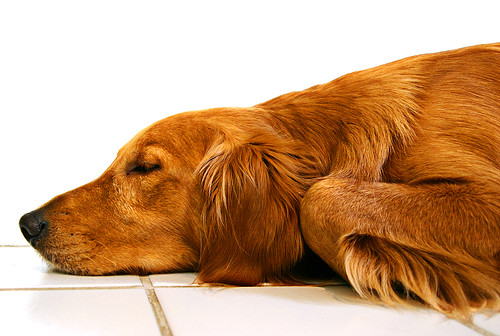The Belgian Shepherd Dog (also known as the Belgian Sheepdog or Chien de Berger Belge) is a breed of of medium to large-sized dog. It is a member of the Sheepdog Group, and as such can be mistaken for the German or King Shepherd, although there exist substantial structural and size differences between Belgian and German shepherd dogs. Four types have been identified by various registries as separate breeds or varieties: Groenendael, Laekenois, Tervuren, and the Malinois. All are registered as a herding dog, more specifically a sheep dog.
Thursday, July 30, 2009
Belgian Sheepdog
Labels:
Belgian Sheepdog
Bookmark this post:blogger widgets
Social Bookmarking Blogger Widget |
Monday, July 27, 2009
Belgian Shepherd Dog (Malinois)
The Belgian Shepherd Dog (Malinois) (pronounced /ˈmælɪnwɑː/) is a breed of dog, sometimes classified as a variety of the Belgian Shepherd Dog rather than as a separate breed. The Malinois is recognized in the United States under the name Belgian Malinois. Its name is the French word for Mechlinian, which is in Dutch either 'Mechelse' (from Mechelen) or 'Mechelaar' (one from Mechelen). In Belgium, their country of origin, they are known by their Flemish name Mechelse Herder.
Like all Belgian Shepherds, the Malinois is a medium-sized, hard-working, square-proportioned dog in the sheepdog family. The Malinois is recognized by its short brownish yellow coat and its black ears that stick straight up, cheeks, and muzzle. It resembles a smaller German Shepherd.
Appearance
Like all Belgian Shepherds, the Malinois is a medium-sized, hard-working, square-proportioned dog in the sheepdog family. The Malinois is recognized by its short brownish yellow coat and its black ears that stick straight up, cheeks, and muzzle. It resembles a smaller German Shepherd.
Coat and color
Due to its history as a working dog, (i.e. being bred for function over form) the Malinois can vary greatly in appearance. The acceptable colors of pure-bred Malinois are a base color fawn to mahogany with a black mask and black ears with some degree of black tipping on the hairs, giving an overlay appearance. The color tends to be lighter with less black agouti or overlay on the dog's underside, breeching, and inner leg. There used to be dogs with grey and black shorthairs but they no longer meet the breed standards.
The other varieties of Belgian Shepherd are distinguished by their coats & colors: the Tervuren is the same color as the Malinois but grey is also possible with long hair, the Laekenois is the same color, only it may lack the black mask & ears, and has wirehair, the Groenendael (registered as Belgian Sheepdog by the American Kennel Club) has long hair and is solid black. There are (occasionally and historically) solid black, black-and-tan (as with Dobermans and German Shepherd Dogs), or other colored short-haired Belgian Shepherds, but these are not technically Malinois.
If a dog represented as a Malinios is brindle (clear stripes of different colored hair) it is probably a Dutch Shepherd Dog or a mixed breed, although the possibility exists that it is a "throwback" to a common continental shepherd ancestor.
Malinois dogs are about 24-26 in. (61-66 cm), while bitches are about 22-24 in. (56-61 cm) at the withers. Bitches are said to average 25-30 kg (55-65 lb), while dogs are heavier at 29-34 kg (65-75 lb). They are squarely built.
In Belgium, Germany, the Netherlands and other European countries, as well as in the United States, Canada and Australia, the Malinois is bred primarily as a working dog for personal protection, detection, police work, search and rescue, and sport work (Belgian Ring, Schutzhund, French Ring, Mondio Ring). The United States Secret Service & Royal Australian Air Force uses the breed exclusively.
The dog is also used extensively by Unit Oketz of the Israel Defense Forces. Oketz favors the slighter build of the Malinois to the German Shepherd and Rottweiler, which were employed formerly.
The other varieties of Belgian Shepherd are distinguished by their coats & colors: the Tervuren is the same color as the Malinois but grey is also possible with long hair, the Laekenois is the same color, only it may lack the black mask & ears, and has wirehair, the Groenendael (registered as Belgian Sheepdog by the American Kennel Club) has long hair and is solid black. There are (occasionally and historically) solid black, black-and-tan (as with Dobermans and German Shepherd Dogs), or other colored short-haired Belgian Shepherds, but these are not technically Malinois.
If a dog represented as a Malinios is brindle (clear stripes of different colored hair) it is probably a Dutch Shepherd Dog or a mixed breed, although the possibility exists that it is a "throwback" to a common continental shepherd ancestor.
Size
Malinois dogs are about 24-26 in. (61-66 cm), while bitches are about 22-24 in. (56-61 cm) at the withers. Bitches are said to average 25-30 kg (55-65 lb), while dogs are heavier at 29-34 kg (65-75 lb). They are squarely built.
Working dog
In Belgium, Germany, the Netherlands and other European countries, as well as in the United States, Canada and Australia, the Malinois is bred primarily as a working dog for personal protection, detection, police work, search and rescue, and sport work (Belgian Ring, Schutzhund, French Ring, Mondio Ring). The United States Secret Service & Royal Australian Air Force uses the breed exclusively.
The dog is also used extensively by Unit Oketz of the Israel Defense Forces. Oketz favors the slighter build of the Malinois to the German Shepherd and Rottweiler, which were employed formerly.
Labels:
Belgian Shepherd Dog (Malinois)
Bookmark this post:blogger widgets
Social Bookmarking Blogger Widget |
Bedlington Terrier
The Bedlington Terrier is a breed of terrier named after the mining town of Bedlington, Northumberland in North East England.
Description
The Bedlington Terrier is often described as looking like a lamb on a leash, probably because it has non-shedding fur with a woolly texture. These dogs may be blue, sandy, liver, or dark brown/black and sable and can be solid colours or have tan markings. These become paler as the dog grows older, but should never be pure white, which indicates a lack of "guard hairs;" the harsh hairs in their coat that give it texture and offer the dogs protection.
This breed has a wedge-shaped head with sparkling, triangular eyes. Although it looks meek when in repose, the Bedlington Terrier is every inch a terrier when aroused. Its body shape, however, is unusual for a terrier, being somewhat like a Greyhound or Whippet in construction, which enables it to gallop at great speed. However, the front legs are constructed differently from those quick hounds (and almost all other breeds of dogs) in that the front legs are closer together at the feet than at the elbows - creating a triangular shape when viewed from the front. This enables a Bedlington Terrier to turn or pivot quickly when chasing quarry at high speed. The Bedlington moves with unique, light movement and seems to "float" above the ground. It should never have a hackney gait (the high-stepping action of some ponies, miniature pinschers or Italian greyhounds. They should cover ground effortlessly, but with power and grace.
Bedlington Terriers are groomed with long hair left on the top of their skull and muzzle, tassels on the ears and slightly longer furnishings on the legs than the body coat. This practice is thought to have originated when the Bedlington was used to hunt vermin. The quarry, trying to escape, would bite at the dog, and the hair saved the Bedlington from an injury to the important facial area and possible death from an infection. A similar idea is seen in the tail, crest and wings of the Secretary Bird
This breed has a wedge-shaped head with sparkling, triangular eyes. Although it looks meek when in repose, the Bedlington Terrier is every inch a terrier when aroused. Its body shape, however, is unusual for a terrier, being somewhat like a Greyhound or Whippet in construction, which enables it to gallop at great speed. However, the front legs are constructed differently from those quick hounds (and almost all other breeds of dogs) in that the front legs are closer together at the feet than at the elbows - creating a triangular shape when viewed from the front. This enables a Bedlington Terrier to turn or pivot quickly when chasing quarry at high speed. The Bedlington moves with unique, light movement and seems to "float" above the ground. It should never have a hackney gait (the high-stepping action of some ponies, miniature pinschers or Italian greyhounds. They should cover ground effortlessly, but with power and grace.
Bedlington Terriers are groomed with long hair left on the top of their skull and muzzle, tassels on the ears and slightly longer furnishings on the legs than the body coat. This practice is thought to have originated when the Bedlington was used to hunt vermin. The quarry, trying to escape, would bite at the dog, and the hair saved the Bedlington from an injury to the important facial area and possible death from an infection. A similar idea is seen in the tail, crest and wings of the Secretary Bird
Grooming
Weekly combing and professional grooming are needed every 6-8 weeks to keep their coats (which tend to curl) in good shape. Dogs being prepared for the show ring often have much more hair left on them than those in "pet clips," which provide pet owners with a more manageable trim for their pets. The show trim is entirely hand-scissored, with the exception of the ears, face/throat, belly and tail which are trimmed with an electric clipper. It can take years to master the grooming pattern for this breed.
Exercise
These high-energy dogs need several vigorous walks and aerobic play sessions daily to keep them happy and content. The breed is well suited for agility, earthdog, obedience and other performance events.
Labels:
Bedlington Terrier
Bookmark this post:blogger widgets
Social Bookmarking Blogger Widget |
Friday, July 24, 2009
Maltese
The Maltese is a small breed of dog in the toy group, known for its silky white hair, though many owners of pet Maltese give them a short "puppy cut" for ease of grooming. The Maltese breed is descended from dogs originating in the Central Mediterranean Area.
Though the name appears to refer to the island of Malta, the origins of both the breed and its name are unclear. Various writings have also described the name as deriving from the Adriatic island of Mljet, and the Sicilian town of Melita. The Fédération Cynologique Internationale, states the name of the dog does not signify that he originates from the island of Malta because the adjective »Maltese« comes from the Semitic word, màlat, a common root of the name of all three places.
Though the name appears to refer to the island of Malta, the origins of both the breed and its name are unclear. Various writings have also described the name as deriving from the Adriatic island of Mljet, and the Sicilian town of Melita. The Fédération Cynologique Internationale, states the name of the dog does not signify that he originates from the island of Malta because the adjective »Maltese« comes from the Semitic word, màlat, a common root of the name of all three places.
The Maltese had been recognized as a FCI breed under the patronage of Italy in 1954 at the Annual meeting in Interlaken, Switzerland. The current FCI standard is dated November 27, 1989, and the latest translation from Italian to English is dated April 6, 1998. The American Kennel Club recognized the breed in 1888, its latest standard being from March 10, 1964.
Characteristics include slightly rounded skulls, with a one-finger-wide dome and a black nose that is two finger widths long. The body is compact with the length equaling the height. The drop ears with long hair and very dark eyes, surrounded by darker skin pigmentation (called a "halo"), gives Maltese their expressive look. Their noses can fade and become pink or light brown in color without exposure to sunlight. This is often referred to as a "winter nose" and many times will become black again with increased exposure to the sun.
The coat is long and silky and lacks an undercoat. The color is pure white and although cream or light lemon ears are permissible, they are not desirable. Also a pale ivory tinge is permitted. Traces of pale orange shades are tolerated but not desirable and considered an imperfection.
Characteristics include slightly rounded skulls, with a one-finger-wide dome and a black nose that is two finger widths long. The body is compact with the length equaling the height. The drop ears with long hair and very dark eyes, surrounded by darker skin pigmentation (called a "halo"), gives Maltese their expressive look. Their noses can fade and become pink or light brown in color without exposure to sunlight. This is often referred to as a "winter nose" and many times will become black again with increased exposure to the sun.
The coat is long and silky and lacks an undercoat. The color is pure white and although cream or light lemon ears are permissible, they are not desirable. Also a pale ivory tinge is permitted. Traces of pale orange shades are tolerated but not desirable and considered an imperfection.
Adult Maltese range from roughly 3 to 7 lb (1.4 to 3.2 kg), though breed standards, as a whole, call for weights between 4 and 7 lb (1.8 and 3.2 kg). There are variations depending on which standard is being used. Many, like the American Kennel Club, call for a weight that is ideally less than 7 lb with between 4 and 6 lb preferred.
Maltese are bred to be cuddly companion dogs. They thrive on love and attention. They are extremely lively and playful, and even as a Maltese ages, his or her energy level and playful demeanor remains fairly constant and does not diminish much. Some Maltese can occasionally be snappy with smaller children and should be supervised when playing, although socializing them at a young age will reduce this habit. The Maltese is very active within a house, and, preferring enclosed spaces, does very well with small yards. For this reason the breed also does well with apartments and townhouses, and is a prized pet of urban dwellers. Maltese have a bad reputation as yappers.
An Australia-wide research project (but not in Tasmania) in conjunction with RSPCA found owners likely to dump their Maltese terriers, citing their tendency to bark constantly. This breed is Australia's most dumped dog.
Maltese are bred to be cuddly companion dogs. They thrive on love and attention. They are extremely lively and playful, and even as a Maltese ages, his or her energy level and playful demeanor remains fairly constant and does not diminish much. Some Maltese can occasionally be snappy with smaller children and should be supervised when playing, although socializing them at a young age will reduce this habit. The Maltese is very active within a house, and, preferring enclosed spaces, does very well with small yards. For this reason the breed also does well with apartments and townhouses, and is a prized pet of urban dwellers. Maltese have a bad reputation as yappers.
An Australia-wide research project (but not in Tasmania) in conjunction with RSPCA found owners likely to dump their Maltese terriers, citing their tendency to bark constantly. This breed is Australia's most dumped dog.
Labels:
Maltese
Bookmark this post:blogger widgets
Social Bookmarking Blogger Widget |
Monday, July 20, 2009
Beauceron
The Beauceron is a herding dog breed from the plains region, between the Seine and Loir rivers, surrounding Paris, France, known as La Beauce. It is also known as Berger de Beauce, Bas Rouge or French Shorthaired Shepherd.
This breed stands 61 to 70 cm (24 to 27.5 inches) in height and weighs 30 to 38.5 kg (66 to 85 pounds). Its standard colouring is black and tan as well as black, tan and grey (harlequin). Other colours, such as the once prevalent tawny, grey or grey/black, are now banned by the breed standard. The coat is short, close and smooth except on legs, tail and flanks, where there is a slight fringe.
Although most breeds may or may not have dewclaws (many owners remove dewclaws, especially if the dog is used for field and hunting), an important feature of the Beauceron is the double dewclaw. A beauceron must have double dewclaws, which form well separated “thumbs” with nails on each rear leg, anything less will result in disqualification.
This breed stands 61 to 70 cm (24 to 27.5 inches) in height and weighs 30 to 38.5 kg (66 to 85 pounds). Its standard colouring is black and tan as well as black, tan and grey (harlequin). Other colours, such as the once prevalent tawny, grey or grey/black, are now banned by the breed standard. The coat is short, close and smooth except on legs, tail and flanks, where there is a slight fringe.
Although most breeds may or may not have dewclaws (many owners remove dewclaws, especially if the dog is used for field and hunting), an important feature of the Beauceron is the double dewclaw. A beauceron must have double dewclaws, which form well separated “thumbs” with nails on each rear leg, anything less will result in disqualification.
Labels:
Beauceron
Bookmark this post:blogger widgets
Social Bookmarking Blogger Widget |
Sunday, July 19, 2009
Bulldog
A Bulldog, colloquially known as the British Bulldog, or English Bulldog, is a type of dog which traces its ancestry to England. It should not be confused with other varieties such as the American Bulldog or the French Bulldog, which has a similar appearance.
The bulldog is a stocky breed with characteristically broad shoulders and a matching wide head. There are generally thick folds of skin on a bulldog's brow, followed by round, dark, far apart eyes, a short muzzle, drooping lips, and the famous underbite.
Bulldogs come in a variety of colors and ideally have a smooth, short coat. The colors, in order of desirability, are brindle (especially red brindle), red (similar to a chestnut horse), white, and fawn (often with white markings on any color, or piebald). The prime disqualifier for the breed in the show ring is a pale or liver-colored nose (although black-coated bulldogs are not preferred, and many judges will dismiss a bulldog lacking an underbite).
In the US, the size of a typical mature male is about 50 pounds and that for mature females is about 40 pounds. In the [United Kingdom], the breed standard is 55 pounds for a male and 50 pounds for a female, though it is not uncommon for males to be 70 pounds.
While some canine breeds require their tails to be cut or "cropped" soon after birth, bulldogs are one of very few breeds whose tail is naturally short and curled. A longer or "gay" tail is a serious fault in a show bulldog.
Bulldogs come in a variety of colors and ideally have a smooth, short coat. The colors, in order of desirability, are brindle (especially red brindle), red (similar to a chestnut horse), white, and fawn (often with white markings on any color, or piebald). The prime disqualifier for the breed in the show ring is a pale or liver-colored nose (although black-coated bulldogs are not preferred, and many judges will dismiss a bulldog lacking an underbite).
In the US, the size of a typical mature male is about 50 pounds and that for mature females is about 40 pounds. In the [United Kingdom], the breed standard is 55 pounds for a male and 50 pounds for a female, though it is not uncommon for males to be 70 pounds.
While some canine breeds require their tails to be cut or "cropped" soon after birth, bulldogs are one of very few breeds whose tail is naturally short and curled. A longer or "gay" tail is a serious fault in a show bulldog.
Despite their famous "sourmug" expression, bulldogs are generally docile although can prove to be very fast movers over a short distance. They are friendly and gregarious but occasionally willful. The phrase "stubborn as a bulldog" is loosely rooted in fact.
Breeders have worked to breed aggression out of the breed, and as such the dog is known to be of generally good temperament. Bulldogs can be so attached to home and family that they will not venture out of the yard without a human companion. Due to their friendly nature bulldogs are known for getting along well with children, other dogs and pets.
A bulldog is suitable for houses as well as apartments due to their size. Most bulldogs are content to walk at most half a mile and thus may suit a less-active person. They are not excitable, seldom bark, and are easily trainable as compared with many other breeds.
Breeders have worked to breed aggression out of the breed, and as such the dog is known to be of generally good temperament. Bulldogs can be so attached to home and family that they will not venture out of the yard without a human companion. Due to their friendly nature bulldogs are known for getting along well with children, other dogs and pets.
A bulldog is suitable for houses as well as apartments due to their size. Most bulldogs are content to walk at most half a mile and thus may suit a less-active person. They are not excitable, seldom bark, and are easily trainable as compared with many other breeds.
The bulldog's unique traits sometimes contribute to specific health issues. Breathing problems can be prevalent in the breed due to the shape and the shortness of its muzzle. Most noticeably, bulldogs are known to snore loudly.
Some individuals of this breed are prone to interdigital cysts, which are cysts that form between the toes. These cause the dog some discomfort, but are treatable either by vet or an experienced owner.
Other problems can include cherry eye, a protrusion of the inner eyelid (which can be corrected by a veterinarian), certain allergies, and hip issues in older bulldogs. However, bulldogs are bred to be bowlegged in the hind-legs and thus do not usually develop hip dysplasia.
Puppies are frequently delivered by Caesarean section because their characteristically large heads can become lodged in the mother's birth canal during natural birth. However, it is not entirely uncommon for a bulldog to whelp naturally and successfully.
The folds or "rope" on a Bulldog's face should be cleaned daily to avoid unwanted infections caused by moisture accumulation. Also, some bulldogs' naturally curling tails can be so tight to the body as to require regular cleaning and a bit of ointment.
Like all dogs, bulldogs require daily exercise. If not properly exercised it is possible for a bulldog to become overweight, which could lead to heart and lung problems, as well as joint issues.
Bulldogs are extremely sensitive to heat. Extra caution should be practiced in warmer climates and during summer months. Bulldogs must be given plenty of shade and water, and must be kept out of standing heat.
In January 2009, after the BBC documentary Pedigree Dogs Exposed, the The Kennel Club introduced revised breed standards for the British Bulldog, along with 209 other breeds, to address health concerns. Opposed by the British Bulldog Breed Council, it was speculated by the press that the changes would lead to a smaller head, less skin folds, a longer muzzle, and a taller thinner posture, in order to combat perceived problems with respiration and with breeding due to head size and posture.
Some individuals of this breed are prone to interdigital cysts, which are cysts that form between the toes. These cause the dog some discomfort, but are treatable either by vet or an experienced owner.
Other problems can include cherry eye, a protrusion of the inner eyelid (which can be corrected by a veterinarian), certain allergies, and hip issues in older bulldogs. However, bulldogs are bred to be bowlegged in the hind-legs and thus do not usually develop hip dysplasia.
Puppies are frequently delivered by Caesarean section because their characteristically large heads can become lodged in the mother's birth canal during natural birth. However, it is not entirely uncommon for a bulldog to whelp naturally and successfully.
The folds or "rope" on a Bulldog's face should be cleaned daily to avoid unwanted infections caused by moisture accumulation. Also, some bulldogs' naturally curling tails can be so tight to the body as to require regular cleaning and a bit of ointment.
Like all dogs, bulldogs require daily exercise. If not properly exercised it is possible for a bulldog to become overweight, which could lead to heart and lung problems, as well as joint issues.
Bulldogs are extremely sensitive to heat. Extra caution should be practiced in warmer climates and during summer months. Bulldogs must be given plenty of shade and water, and must be kept out of standing heat.
In January 2009, after the BBC documentary Pedigree Dogs Exposed, the The Kennel Club introduced revised breed standards for the British Bulldog, along with 209 other breeds, to address health concerns. Opposed by the British Bulldog Breed Council, it was speculated by the press that the changes would lead to a smaller head, less skin folds, a longer muzzle, and a taller thinner posture, in order to combat perceived problems with respiration and with breeding due to head size and posture.
Labels:
Bulldog
Bookmark this post:blogger widgets
Social Bookmarking Blogger Widget |
Saturday, July 18, 2009
Carolina Dog
The Carolina Dog, or American Dingo, is a type of wild dog discovered in the late 1970s. They were located living in isolated stretches of longleaf pines and cypress swamps in the Southeastern United States. They are dogs of medium size, with a fawn coat and frequently a melanistic mask.
Labels:
Carolina Dog
Bookmark this post:blogger widgets
Social Bookmarking Blogger Widget |
Thursday, July 16, 2009
Cane Corso Mastiff
The Cane Corso is an Italian breed of dog used mainly as a guard dog. It is of the large molosser type.
The Cane Corso is a large mollossoid. It is well muscled and looks more athletic than most other mastiffs, tending less toward sheer bulk like the English Mastiff and more towards definition like the original Old English Bulldog. The official FCI standard calls for dogs to stand from 60-68cm (23.6-26.7 inches) at the withers, with females in the lower region and males in the higher. Weight should be in keeping with the size and stature of these dogs, ranging from 40-50 kg (88-110lbs). The overall impression should be of power balanced with athleticism.
Its ears are naturally dropped forward, but where legal, many breeders crop them short and close to the head so that the remaining stubs stand upright. Its muzzle is as wide as it is long. Most Corsos have docked tails as well. The standard calls for docking at the 4th vertebra. Some are docked shorter due to unfamiliarity with the breed standard.
Corsos appear in two basic coat colours: black and fawn. This is further modified by genetic pigment dilution to create blue (from black) and formentino (from fawn) colours. Brindling of varying intensity is common on both basic coat colours as well, creating tigrato (full brindle), black brindle, and blue brindle. Fawn also has a number of different expressions, ranging from the pale of a formentino to 'red' to the more common beige colour, with the back coat hairs tipped with black. In blue dogs, the nose can appear grey, but should be darker than the coat. In all other dogs, the nose should be black. White markings on the chest, toes and on the chin are seen as well, with smaller white patches being preferable.
The Cane Corso is a large mollossoid. It is well muscled and looks more athletic than most other mastiffs, tending less toward sheer bulk like the English Mastiff and more towards definition like the original Old English Bulldog. The official FCI standard calls for dogs to stand from 60-68cm (23.6-26.7 inches) at the withers, with females in the lower region and males in the higher. Weight should be in keeping with the size and stature of these dogs, ranging from 40-50 kg (88-110lbs). The overall impression should be of power balanced with athleticism.
Its ears are naturally dropped forward, but where legal, many breeders crop them short and close to the head so that the remaining stubs stand upright. Its muzzle is as wide as it is long. Most Corsos have docked tails as well. The standard calls for docking at the 4th vertebra. Some are docked shorter due to unfamiliarity with the breed standard.
Corsos appear in two basic coat colours: black and fawn. This is further modified by genetic pigment dilution to create blue (from black) and formentino (from fawn) colours. Brindling of varying intensity is common on both basic coat colours as well, creating tigrato (full brindle), black brindle, and blue brindle. Fawn also has a number of different expressions, ranging from the pale of a formentino to 'red' to the more common beige colour, with the back coat hairs tipped with black. In blue dogs, the nose can appear grey, but should be darker than the coat. In all other dogs, the nose should be black. White markings on the chest, toes and on the chin are seen as well, with smaller white patches being preferable.
Cane Corso are considered to have an even, stable temperament. They are easy to train, generally good with children, and calm with their primary guardians. They can be reserved, suspicious and may be aggressive toward people they do not know, if not properly socialized. Corsos tend to be a quiet breed.
The true Corso should be indifferent when approached and should only react when a real threat is present. However, "the majority of the American version of the Corso do not possess the proper temperament for this breed."
The true Corso should be indifferent when approached and should only react when a real threat is present. However, "the majority of the American version of the Corso do not possess the proper temperament for this breed."
As a recently recovered breed, the Cane Corso's history is shrouded in mystery and differing opinions. It is generally agreed that the Cane Corso is a farm dog which has been used for stock control, property and personal protection and big game hunting throughout its history. The breed was recovered from near extinction through the efforts of enthusiasts in the 1980's, the Corso is now popular globally, as can be seen by Lebron James, Laila Ali, and Tracy Morgan's ownership of Cane Corsos.
The Corso is likely derived from the same root stock as the Neapolitan Mastiff; the historically documented Roman war dog "Canes Pugnaces". The Corso favours agility and speed, where the Neapolitan is known for power and strength.
The Corso is likely derived from the same root stock as the Neapolitan Mastiff; the historically documented Roman war dog "Canes Pugnaces". The Corso favours agility and speed, where the Neapolitan is known for power and strength.
Labels:
Cane Corso Mastiff
Bookmark this post:blogger widgets
Social Bookmarking Blogger Widget |
Sunday, July 12, 2009
Cairn Terrier
The Cairn Terrier is one of the oldest terrier breeds, originating in the Scottish Highlands and recognized as one of Scotland's earliest working dogs, used for hunting burrowing prey among the cairns.
Although the breed had existed long before, the name Cairn Terrier was a compromise suggestion after the breed was originally brought to official shows in the United Kingdom in 1909 under the name Short-haired Skye terriers. This name was not acceptable to The Kennel Club due to opposition from Skye Terrier breeders, and the name Cairn Terrier was suggested as an alternative. The Cairn Terrier quickly became popular and has remained so ever since. They are usually left-pawed. Cairn Terriers are ratters. In Ireland they would search the cairns (large rock piles) for rats and other rodents. Thus if one is kept as a house hold pet it will do the job of a cat, specifically catching and killing mice, rabbits, and squirrels.
Although the breed had existed long before, the name Cairn Terrier was a compromise suggestion after the breed was originally brought to official shows in the United Kingdom in 1909 under the name Short-haired Skye terriers. This name was not acceptable to The Kennel Club due to opposition from Skye Terrier breeders, and the name Cairn Terrier was suggested as an alternative. The Cairn Terrier quickly became popular and has remained so ever since. They are usually left-pawed. Cairn Terriers are ratters. In Ireland they would search the cairns (large rock piles) for rats and other rodents. Thus if one is kept as a house hold pet it will do the job of a cat, specifically catching and killing mice, rabbits, and squirrels.
Labels:
Cairn Terrier
Bookmark this post:blogger widgets
Social Bookmarking Blogger Widget |
Thursday, July 9, 2009
English Coonhound
The English Coonhound, sometimes referred to as the "Redtick Coonhound", is a breed of dog. It is a type of coonhound that is typically bred in the southern United States.
Appearance
Colouration
Unlike the other classifications of coonhounds, a variety of colourations is acceptable to meet English coonhound breed standards. Colouration can be redtick, bluetick, tricoloured and tricoloured with ticking. However, red markings are predominant and "Redtick" is a common euphemism for English Coonhounds. Some people believe this lack of emphasis on specific colouration has allowed breeders to focus breeding programs on traits such as intelligence and hunting ability rather than superficial concerns like coat standards. Colour variations are common even amongst pups from the same litter of English coonhounds, indicating high levels of DNA diversity in the breed.
Temperament
Like all coonhounds, English are generally good natured and very sociable dogs. Skittishness or aggression is considered a defect according to UKC breed standards. They are strong willed, if not stubborn, and require more patience in training than other breeds. Young dogs are usually extremely active and playful and desirous of human attention in addition to requiring plenty of exercise. English Coonhounds are incessant nesters and should be avoided by people who do not wish to have dogs on couches and beds. They make excellent family pets as they have been bred for hunting purposes to coexist amiably within a pack. English Coonhounds also make adequate watch dogs as they possess extremely loud hound mouths characterized by melodious, drawn out bawls and short, explosive chops.
History
This breed was originally classified and registered as the English Fox and Coonhound prior to the specialization of the six breeds of coonhounds. The recognition in the 1940s by the United Kennel Club of Bluetick and Treeing Walker coonhounds as distinct breeds led to the parring down of the English Coonhound classification. The breed originated in the southeastern United States where they were bred from American and English Foxhounds, other European hunting breeds, and native dogs for the purpose of trailing and treeing a variety of animals.
Hunting
English Coonhounds are often kept as hunting dogs used to trail and tree animals, primarily raccoons. They also compete in competition hunts known as "nite" hunts, the largest of which are English Days and Southern English Days which also feature show competitions and water trials.
Labels:
English Coonhound
Bookmark this post:blogger widgets
Social Bookmarking Blogger Widget |
Tuesday, July 7, 2009
Alapaha Blue Blood Bulldog
The Alapaha Blue Blood Bulldog (ABBB) or Otto is an American rare dog breed, developed in the Alapaha River region of Southern Georgia.
Displaying an unexaggerated and natural bulldog type, the Alapaha is nevertheless a sturdy, well-developed, and muscular breed. Descriptions of its size vary greatly, calling for males anywhere from 75 to 95 pounds (34 to 43 kg) give or take 10 lbs standing 22 to 26 inches (56 to 66 cm) at the withers, females smaller at 60 to 70 pounds (27 to 32 kg).
Ears and tail are natural, with no cropping or docking. Colors of the Alapaha are varied, typically white or different shades of black, grey, red,white, fawn, brindle, brown, buckskin, or mahogany, always Trimmed with white markings; some dogs are piebald spotted.
Displaying an unexaggerated and natural bulldog type, the Alapaha is nevertheless a sturdy, well-developed, and muscular breed. Descriptions of its size vary greatly, calling for males anywhere from 75 to 95 pounds (34 to 43 kg) give or take 10 lbs standing 22 to 26 inches (56 to 66 cm) at the withers, females smaller at 60 to 70 pounds (27 to 32 kg).
Ears and tail are natural, with no cropping or docking. Colors of the Alapaha are varied, typically white or different shades of black, grey, red,white, fawn, brindle, brown, buckskin, or mahogany, always Trimmed with white markings; some dogs are piebald spotted.
Labels:
Alapaha Blue Blood Bulldog
Bookmark this post:blogger widgets
Social Bookmarking Blogger Widget |
Sunday, July 5, 2009
Pug
The Pug is a small breed of dog with a wrinkly, short muzzled face . The word "pug" may have come from the Old English pugg or "puge", which were affectionate terms for a playful little devil or monkey. Pug puppies are often called puglets. The breed is often summarized as multum in parvo ("much in little"), describing the Pug's remarkable personality despite its small size.
While most Pugs appearing in eighteenth century prints tended to be long and lean, modern breed preferences are for a square, cobby body, a compact form, a deep chest, and well-developed muscle. Breeding preference goes to "button" Pugs. The legs are very strong, straight, of moderate length, and are set well under. The shoulders are moderately laid back. The pasterns are strong, neither steep nor down. The feet are neither so long as the foot of the hare, nor so round as that of the cat; well split-up toes, and the nails black. Dewclaws are generally removed. The lower teeth normally protrude further than their upper, meeting in an under-bite.
While most Pugs appearing in eighteenth century prints tended to be long and lean, modern breed preferences are for a square, cobby body, a compact form, a deep chest, and well-developed muscle. Breeding preference goes to "button" Pugs. The legs are very strong, straight, of moderate length, and are set well under. The shoulders are moderately laid back. The pasterns are strong, neither steep nor down. The feet are neither so long as the foot of the hare, nor so round as that of the cat; well split-up toes, and the nails black. Dewclaws are generally removed. The lower teeth normally protrude further than their upper, meeting in an under-bite.
Their fine, glossy coats can be fawn, apricot, silver or black. A silver coat is characterized by a very light coloured coat, absent of black guard hairs. Some breeders call "smutty" Pugs silver. A "smutty" Pug typically has a very dark head, with no clear delineation at the mask, and dark forelegs. The markings are clearly defined. The trace is a black line extending from the occiput to the tail. The tail normally curls tightly over the hip.
Pugs of different coat types shed to varying degrees, but they all shed quite a bit year round. Fawn Pugs, which have both an undercoat and an overcoat, are the most notorious for shedding. Pug owners have gone to great lengths to control this Pug characteristic. Partial solutions to the problem involve using special shampoos, supplementing or changing the Pug's diet, or even trimming the Pug's coat. Alternatively, regular coat grooming can keep the shedding down.
Pugs of different coat types shed to varying degrees, but they all shed quite a bit year round. Fawn Pugs, which have both an undercoat and an overcoat, are the most notorious for shedding. Pug owners have gone to great lengths to control this Pug characteristic. Partial solutions to the problem involve using special shampoos, supplementing or changing the Pug's diet, or even trimming the Pug's coat. Alternatively, regular coat grooming can keep the shedding down.
Labels:
Pug
Bookmark this post:blogger widgets
Social Bookmarking Blogger Widget |
Funny Dog Dancing
This video about funny dog
Labels:
Video
Bookmark this post:blogger widgets
Social Bookmarking Blogger Widget |
Friday, July 3, 2009
Dachshund
The dachshund is a short-legged, elongated dog breed of the hound family. Variations of the pronunciation include däks'hoont, -hʊnt, -hʊnd, -ənd, dɑks-, dæks-, dæʃ-), the breed's name is German and literally means "badger dog", from [der] Dachs, "badger", and [der] Hund, "dog". Due to the long, narrow build, they are sometimes referred to as a wiener dog or a sausage dog. Not withstanding the German origin of the dachshund's name, within German-speaking countries, the breed is known—both formally and informally—as the Dackel, or in the case of certified hunting and tracking rank, as Teckel.
While classified in the hound group or scent hound group in the United States and Great Britain, there may be some who consider the classification to be arguable, speculating that it arose from the fact that the word Hund, is similar to the English word hound, and the word "Dachshund" has even been both pronounced and translated, albeit incorrectly, as "Dash Hound".
Many dachshunds, especially the wire-haired sub type, may exhibit behavior and appearance that are similar to that of the terrier group of dogs. The standard size was developed to scent, chase, and flush badgers and other burrow-dwelling animals, while the miniature was developed to hunt smaller prey, like rabbits.
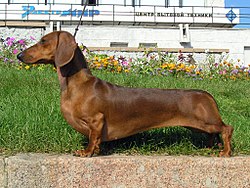 An argument can be made for the scent or hound group classification because the breed was developed to utilize scent to trail and hunt animals, and probably descended from scent hounds, such as bloodhounds, pointers, Basset Hounds, or even Bruno Jura Hounds; with the dogged and persistent personality and love for digging that probably developed from the terrier, it can also be argued that they could belong in the terrier, or "earth dog", group.
An argument can be made for the scent or hound group classification because the breed was developed to utilize scent to trail and hunt animals, and probably descended from scent hounds, such as bloodhounds, pointers, Basset Hounds, or even Bruno Jura Hounds; with the dogged and persistent personality and love for digging that probably developed from the terrier, it can also be argued that they could belong in the terrier, or "earth dog", group.
In the Fédération Cynologique Internationale (World Canine Federation), or FCI, the dachshund is actually in its own group, Group 4, which is the dachshund group. Part of the controversy is due to the fact that the dachshund is the only certifiable breed of dog to hunt both above and below ground.
While classified in the hound group or scent hound group in the United States and Great Britain, there may be some who consider the classification to be arguable, speculating that it arose from the fact that the word Hund, is similar to the English word hound, and the word "Dachshund" has even been both pronounced and translated, albeit incorrectly, as "Dash Hound".
Many dachshunds, especially the wire-haired sub type, may exhibit behavior and appearance that are similar to that of the terrier group of dogs. The standard size was developed to scent, chase, and flush badgers and other burrow-dwelling animals, while the miniature was developed to hunt smaller prey, like rabbits.
 An argument can be made for the scent or hound group classification because the breed was developed to utilize scent to trail and hunt animals, and probably descended from scent hounds, such as bloodhounds, pointers, Basset Hounds, or even Bruno Jura Hounds; with the dogged and persistent personality and love for digging that probably developed from the terrier, it can also be argued that they could belong in the terrier, or "earth dog", group.
An argument can be made for the scent or hound group classification because the breed was developed to utilize scent to trail and hunt animals, and probably descended from scent hounds, such as bloodhounds, pointers, Basset Hounds, or even Bruno Jura Hounds; with the dogged and persistent personality and love for digging that probably developed from the terrier, it can also be argued that they could belong in the terrier, or "earth dog", group.In the Fédération Cynologique Internationale (World Canine Federation), or FCI, the dachshund is actually in its own group, Group 4, which is the dachshund group. Part of the controversy is due to the fact that the dachshund is the only certifiable breed of dog to hunt both above and below ground.
Labels:
Dachshund
Bookmark this post:blogger widgets
Social Bookmarking Blogger Widget |
Wednesday, July 1, 2009
Golden Retriever
The Golden Retriever is a breed of dog, historically developed as a gundog to retrieve shot waterfowl and upland game during hunting. As such they were bred to have a soft mouth to retrieve game undamaged and an instinctive love of water. Their intelligence and versatility sees them employed in a variety of roles including illegal drug detection, search and rescue, as hunting dogs and as guide dogs. Its friendly, eager-to-please and patient demeanor has made it one of the most popular family dogs (by registration) in the world.
The Golden Retriever was originally developed in Scotland at "Guisachan" near Glen Affric, the highland estate of Sir Dudley Marjoribanks (pronounced "Marʒbanks"), later Baron Tweedmouth. For many years, there was controversy over which breeds were originally crossed. In 1952, the publication of Majoribanks' breeding records from 1835 to 1890 dispelled the myth concerning the purchase of a whole troupe of Russian sheepdogs from a visiting circus.
Improvements in guns during the 1800s resulted in more fowl being downed during hunts at greater distances and over increasingly difficult terrain. This led to more birds being lost in the field. Because of this improvement in firearms, a need for a specialist retriever arose as training setter and pointer breeds in retrieval was found to be ineffective. Thus work began on the breeding of the Golden Retriever to fill this much needed role.
The Golden Retriever was originally developed in Scotland at "Guisachan" near Glen Affric, the highland estate of Sir Dudley Marjoribanks (pronounced "Marʒbanks"), later Baron Tweedmouth. For many years, there was controversy over which breeds were originally crossed. In 1952, the publication of Majoribanks' breeding records from 1835 to 1890 dispelled the myth concerning the purchase of a whole troupe of Russian sheepdogs from a visiting circus.
Improvements in guns during the 1800s resulted in more fowl being downed during hunts at greater distances and over increasingly difficult terrain. This led to more birds being lost in the field. Because of this improvement in firearms, a need for a specialist retriever arose as training setter and pointer breeds in retrieval was found to be ineffective. Thus work began on the breeding of the Golden Retriever to fill this much needed role.
The original cross was of a yellow-coloured Retriever, Nous, with a Tweed Water Spaniel female dog, Belle. The Tweed Water Spaniel is now extinct but was then common in the border country. Majoribanks had purchased Nous in 1865 from an unregistered litter of otherwise black wavy-coated retriever pups. In 1868, this cross produced a litter that included four pups; these four became the basis of a breeding program which included the Irish Setter, the sandy-colored Bloodhound, the St. John's Water Dog of Newfoundland, and two more wavy-coated black Retrievers. The bloodline was also inbred and selected for trueness to Majoribanks' idea of the ultimate hunting dog. His vision included a more vigorous and powerful dog than previous retrievers, one that would still be gentle and trainable. Russian sheepdogs are not mentioned in these records, nor are any other working dog breeds. The ancestry of the Golden Retriever is all sporting dogs, in line with Majoribanks' goals.
Golden Retrievers were first accepted for registration by the The Kennel Club of England in 1903, as Flat Coats - Golden. They were first exhibited in 1908, and in 1911 were recognized as a breed described as Retriever (Golden and Yellow). In 1913, the Golden Retriever Club was founded. The breed name was officially changed to Golden Retriever in 1920.
The Honorable Archie Majoribanks took a Golden Retriever to Canada in 1881, and registered Lady with the American Kennel Club (AKC) in 1894. These are the first records of the breed in these two countries. The breed was first registered in Canada in 1927, and the Golden Retriever Club of Ontario, now the Golden Retriever Club of Canada, was formed in 1958. The co-founders of the GRCC were Cliff Drysdale, an Englishman who had brought over an English Golden and Jutta Baker, daughter in law of Louis Baker who owned Northland Kennels, possibly Canada's first kennel dedicated to Goldens. The AKC recognized the breed in 1925, and in 1938 the Golden Retriever Club of America was formed.
Golden Retrievers were first accepted for registration by the The Kennel Club of England in 1903, as Flat Coats - Golden. They were first exhibited in 1908, and in 1911 were recognized as a breed described as Retriever (Golden and Yellow). In 1913, the Golden Retriever Club was founded. The breed name was officially changed to Golden Retriever in 1920.
The Honorable Archie Majoribanks took a Golden Retriever to Canada in 1881, and registered Lady with the American Kennel Club (AKC) in 1894. These are the first records of the breed in these two countries. The breed was first registered in Canada in 1927, and the Golden Retriever Club of Ontario, now the Golden Retriever Club of Canada, was formed in 1958. The co-founders of the GRCC were Cliff Drysdale, an Englishman who had brought over an English Golden and Jutta Baker, daughter in law of Louis Baker who owned Northland Kennels, possibly Canada's first kennel dedicated to Goldens. The AKC recognized the breed in 1925, and in 1938 the Golden Retriever Club of America was formed.
Labels:
Golden Retriever
Bookmark this post:blogger widgets
Social Bookmarking Blogger Widget |
Subscribe to:
Posts (Atom)
